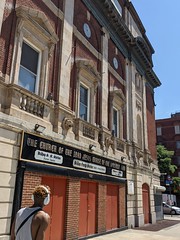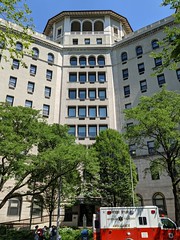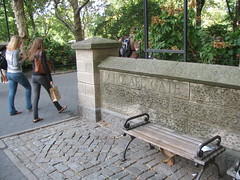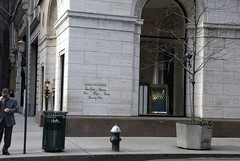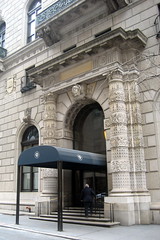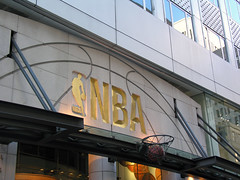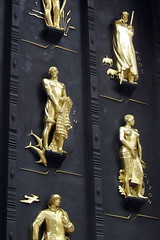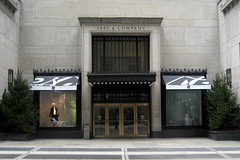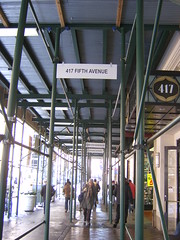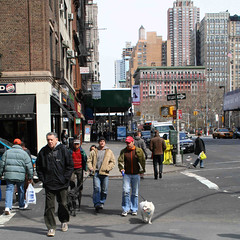West:
Miner's Gate

One of the 20 gates named by the Commis- sioners of Central Park in 1862—though the names were not actually inscribed until 1999. The names were intended to reflect the democratic intentions of the park. The term "miner" was
intended to "include the workers in coal, and the different ores, and also the quarrymen or miners of stone."
As discovered by the website PopSpots, this was the location of the pretzel vendor featured on the cover of the Steely Dan album Pretzel Logic.
Cedar Hill
 A popular hill for sledding in winter, named for the red cedars on its crest. The undulating terrain
reflects glacial scarring.
A popular hill for sledding in winter, named for the red cedars on its crest. The undulating terrain
reflects glacial scarring.
The Glade
 This grassy area is
said to appear in the film Enchanted, part of the "That's How You'll Know" number. Not to be confused with the Children's Glade,
which is on the opposite side of the park. This is the one with
Calvert Vaux's Glade Arch, an 1862 sandstone bridge that used to carry carriage traffic over a footpath, but now just ornamently separates pedestrians from other pedestrians.
This grassy area is
said to appear in the film Enchanted, part of the "That's How You'll Know" number. Not to be confused with the Children's Glade,
which is on the opposite side of the park. This is the one with
Calvert Vaux's Glade Arch, an 1862 sandstone bridge that used to carry carriage traffic over a footpath, but now just ornamently separates pedestrians from other pedestrians.
James Michael Levin Playground

This perimeter playground, built in the 1930s, was dedicated in 1987 to James Michael Levin, a three-year-old killed by a hit-and-run driver in 1959, when his mother
Janice Levin funded its renovation. It's designed to appeal to toddlers.
The playground features the Sophie Irene Loeb Fountain, which portrays characters from Alice's Adventures in Wonderland, including Alice, the Mad Hatter, the White Rabbit and the Cheshire Cat. It was sculpted by
Frederick Roth,
who also made Central Park's Balto and Mother Goose, as well as the dancing bear and goat at the Central Park Zoo.
Sophie Irene Loeb (1876-1929), the fountain's namesake, was a journalist for the New York Evening World and the first president of the Child Welfare Board. One of the many reforms she campaigned for was the addition of playgrounds to Central Park.
Alice in Wonderland

This 1959 sculpture by Jose de Creeft, featuring Alice on a giant mushroom surrounded by characters from the Lewis Carroll book,
is designed to be climbed on by children.
The statue was paid for by George Delacorte, who is the model for the sculpture's Mad Hatter.
Conservatory Water
 Planned as the reflecting pool for a glass conserv- atory that was never built, it's now known as the Model
Boat Pond, famous for the miniature ships sailing its waters, as featured in E.B. White's Stuart Little.
Planned as the reflecting pool for a glass conserv- atory that was never built, it's now known as the Model
Boat Pond, famous for the miniature ships sailing its waters, as featured in E.B. White's Stuart Little.

West of the pond is a statue of Hans Christian Andersen (1805-1875), sculpted by Georg John Lober in 1955.
(Lober also made Times Square's George Cohan.) It's the site of a summer reading program.
The Conservatory Water is a prime spot to watch for Pale Male— maybe the world's most famous bird, and at 31 years old in 2021, the oldest hawk ever recorded in the wild.

On the eastern shore of the Conservatory Water is the Kerbs Memorial Boat House, where model boats are stored and rented (cc photo: Ajay Suresh).
The building was built in 1954 with a donation from
Jeanne Kerbs in honor of her parents; her father, Edward Kerbs, was a wealthy cigar manufacturer.
Pilgrim Hill

Another popular sledding hill, it's named for the statue of a pilgrim by
John Quincy Adams Ward,
given to the park by the New England Society in 1885. (Ward sculpted Indian Hunter,
William Shakespeare and the 7th
Regiment Memorial elsewhere in the park, and George Washington and the Stock Exchange
pediment, both on
Wall Street.)
Waldo Hutchins Bench
 This bench honors
Waldo Hutchins (1822-1891), a commis- sioner of Central Park from 1857-69, and again from
1887-91. The bench bears a Latin motto that translates, "You should live for another if you would
live for yourself." It was designed by Eric Gugler, who redesigned the West Wing for FDR, and
carved by the
Piccirilli Brothers, who made Central Park's Maine memorial, the NYPL lions, the Custom
House continents, the Washington Square Arch's Washingtons, the Stock Exchange pediment, and the
Lincoln in the Lincoln Memorial (cc photo: Gigi NYC).
This bench honors
Waldo Hutchins (1822-1891), a commis- sioner of Central Park from 1857-69, and again from
1887-91. The bench bears a Latin motto that translates, "You should live for another if you would
live for yourself." It was designed by Eric Gugler, who redesigned the West Wing for FDR, and
carved by the
Piccirilli Brothers, who made Central Park's Maine memorial, the NYPL lions, the Custom
House continents, the Washington Square Arch's Washingtons, the Stock Exchange pediment, and the
Lincoln in the Lincoln Memorial (cc photo: Gigi NYC).

A sundial above the bench—which is an hour off during daylight savings time—bears a
bronze figure by sculptor Paul Manship, as well as another Latin motto, which means, "Do not let
time destroy it" (cc photo: Gigi NYC).
A whisper on one end of the bench can be easily heard on the other, due to the curved bench's
acoustics.
|
|
|
East:

Corner (2 E 79th): A five-story townhouse built in 1899
to a CPH Gilbert design, decorated with sea life. The first owner was coal tar magnate Isaac Fletcher; after he died in 1917,
it was bought by Harry Sinclair of Sinclair Oil, who spent a year in prison in connection with the Teapot Dome scandal. In 1930, the house was bought by Augustus van Horne Stuyvesant, the last patrilineal descendant of Peter Stuyvesant. Two years after his death in 1953, it became the headquarters of the Ukrainian Institute of America.

972: This five-story townhouse was built as a wedding present for William Payne Whitney and Helen Hay, given to them by Whitney's fabulously wealthy uncle,
Oliver Payne. (Hay, the daughter of diplomat
John Hay, was a poet and children's book writer.) The house was designed by Stanford White in Italian Renaissance style; it is considered one of his finest houses. It included a fountain with a statue White had purchased in Italy, which turned out to be by Michelangelo; it's currently on display at the Met. The architect was murdered shortly before the house was completed in 1906.
When Payne Whitney died in 1927, the place seems to have been inherited by his son John Hay "Jock" Whitney, though his mother lived here until her death in 1944. The son was a very successful investor; two of his successful ventures were the Broadway hit Life With Father and the film Gone With the Wind. (Rumours that a scene from Gone With the Wind was shot in the house are unconfirmed.) Jock Whitney was the last publisher of the New York Herald Tribune, from 1961-66 (NNY).

Corner (1 E 78th): Built in 1912 for
James Buchanan Duke (1856-1925), a founder of the tobacco trust, to a design by Horace Trumbauer, who emulated the Hotel Lobottiere in Bordeaux. His widow Nanaline and their daughter,
Doris Duke, donated the house in 1958 to NYU to house its Institute of Fine Arts.
The building has been used for such films as Arthur, The Greatest Showman and The Goldfinch.
|

969 (corner): This 1926 building designed by Joseph L. Raimist has 16 stories and 12 apartments. City Realty
dismisses it as "bland" and "not remarkable," but I find it rather handsome. Playwright Edward Albee reportedly lived here.

965: Built in 1941, 19 stories. It replaced the 1901 Jacob Schiff mansion designed by Freeman & Train.
On October 30, 2007,
Linda Stein, former manager of the Ramones, was found murdered in her apartment here. Stein had become a real estate agent with many show biz clients, including Madonna, Sting, Angelina Jolie, Billy Joel, Christie Brinkley, Bruce Willis, Harrison Ford, Sylvester Stallone, Jann Wenner, Andrew Lloyed Webber, Michael Douglas, Steven Spielberg and Elton John. Her former personal assistant bludgeoned her to death because, she claimed, Stein "just kept yelling at her."

962: The address of the
William Clark House,
an ornate Beaux-Arts mansion designed by Lord, Hewlett & Hull
for William Clark, a former senator from Montana who was at first denied a seat because he had bribed state legislators to get it. "I never bought a man who wasn't for sale," he insisted. The house was torn down in 1927 to make way for...

960 (corner): This luxury apartment building, 15 stories completed in 1928 by Warren & Wetmore with assistance from Rosario Candela, is considered one of the three finest residences on Fifth Avenue. Time founder Henry Luce and his wife Clare Boothe Luce were living here until his death in 1967 (NNY). Other notable former residents include billionaire Edgar Bronfman, suspected wife-murderer Claus Von Bulow and poet Louis Untermeyer.
|

956 (corner): This apartment building designed by Isaac Newton Stoke Phelps was built in 1926 with eight stories, in conformance with restrictive zoning limits; when the Appellate Court overturned the
zoning rule, six more stories were added by architect Nathan Korn.
Michael Corleone lives here in Godfather III.
Previously this was the site of Temple Beth-El, built in 1899. It's now merged with
Temple Emanu-el at
Fifth and 65th.

955: An 18-story building from 1938 with 30 apartments, it was designed by Rosario Candela; the lack of detailing reflects Depression-era constraints as well as aesthetic trends. Actor Robert Redford owned the duplex penthouse here from 1985-2002.
953: This slender 15-story building was designed by Isaac Newton Phelps Stokes in 1925 in Neo-Renaissance style.
It has seven apartments, one of which was claimed by the architect.

952: Built with only eight stories in 1923, to conform to a short-lived 75-foot limit on Fifth Avenue apartment buildings. At some point another three stories were added on top in a Modernist style. This is one of the very few buildings on the east edge of Central Park where you can rent and not buy a unit.

950 (corner): A JER Carpenter design from 1926, this Italian Renaissance building has seven apartments on 14 floors. The penthouse triplex was bought by Time Warner chair Steven Ross in 1971, and later sold to publisher Mort Zuckerman. Other tycoons who have lived here include Blackstone's Stephen Schwartzman and Loews Hotel's Jonathan Tisch.
|

945 (corner): A 1949 building by Emery Roth & Sons has 107 units on 19 floors. The octagonal water tower on top "conjures the aesthetics of Mayan temples or battleship leviathans," according to
Carter Horsley.
Previously on this site was the grand-domed Temple Emanu-el, built in 1891. It merged with Temple Beth-el and moved down to 65th Street in 1939.

944: A 1925 Italian Renaissance building designed by Nathan Korn; it has 14 stories and 15 co-op apartments. A white-glove co-op where the doorman actually wears white gloves, it's been home to TV personality Barbara Walters.

Corner (1 East 75th): This was the mansion of Edwin Harkness, an early investor in
Standard Oil and at one point the sixth-richest person in the US. Completed in 1908 to a
James Gamble Rogers design, the marble house reflects what passes for modesty in a
multi-millionaire; for example, it has seven stories but appears to only have four, as two are
underground and the top floor is hidden in the cornice. Harkness insisted that it bear a
75th Street and not a Fifth Avenue address, forcing his neighbor to cover up the "1" carved on the
house next door.
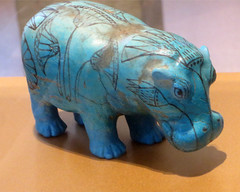
Harkness was a supporter of the Met, with a particular interest in Egypt-ology; he gave the museum its famous blue hippo. He and his wife Mary not only funded the exploration of King Tut's tomb, they visited it a year after its rediscovery.
After the deaths of Harkness and his wife, in 1940 and 1950, respectively, the house was left to the Commonwealth Fund, founded by his mother Anna Harkness in 1918 "to enhance the common good," with a particular focus on healthcare.
|

936 (corner): An 18-story building by Harmon Associates, completed in 1955 with 32 units.
Replaced a 1907 townhouse designed by Carrere & Hastings for arts patron Grace Rainey Rogers,
as well as a 1910 Warren & Wetmore house for S. Reading Bertron.
French Consulate General

934: This Italian Ren-aissance townhouse was built in 1926 for Charles E. Mitchell, president of National City Bank. His architects were Walker & Gillette, who also designed Rye Playland. Mitchell was a pioneer in retail banking and an informal advisor to presidents Harding and Hoover. His wife Elizabeth hosted evenings here with musical stars, most notably George Gershwin. Ruined by the stock market crash and subsequent investigations into financial irregularities, Mitchell was forced to sell the house in 1933. The French government bought it in 1942 to serve as consulate.

930 (corner): A 1940 building by Emery Roth of 19 stories, viewed as transitional between Italian Renaissance and Art Deco. Filmmaker Woody Allen lived in the penthouse with his children's sister, Soon-Yi Previn; another resident was pizza maker Mario Sbarro.
This building replaced houses owned by Gordon S. Rentschler, Jacob Schiff and Simeon B. Chapin.
|
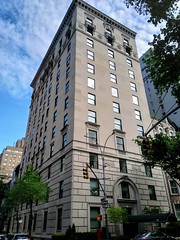
927 (corner): This 12-story building with 12 apartments was built in 1917 to a Warren & Wetmore design. The building has been home to such notables as TV star Mary Tyler Moore, CNN anchor Paula Zahn, financier Bruce Wasserstein and shoe seller Kenneth Cole.
But the most remarkable resident of this building might be
Pale Male, a red-tailed hawk and possibly the world's most famous bird. He arrived in Central Park in 1991, at a time when redtails were an uncommon site in cities. In 1993, he built a nest on 927 with his mate at the time, a hawk known as Chocolate; the nest was initially removed, but was allowed to remain when the hawks rebuilt it. Since then, Pale Male and a series of partners have raised numerous hawk chicks here.

In 2004, the co-op board voted to remove the nest once again; after an international outcry, the board backed down and allowed Pale Male and his mate at the time, Lola, to rebuild. But there hasn't been any successful hatchings at the nest since then.
Pale Male was still alive as of 2021, making him at least 31 years old and one of the oldest hawks on record. (cc photo: Dave Hensley)

926: One of a pair of townhouse survivors, both built in 1899 to designs by CPH Gilbert. In 2008, the lease on this house was bought by Loews Hotel chair Jonathan Tisch for $21 million—purchasing the right to rent the place for $37,000 a year.
925: The smaller of the pair of Gilbert townhouses was originally built for John W. Simpson, founder of the law firm
Simpson Thacher & Bartlett, which helped KKR take over RJR Nabisco and assisted in the IPOs for Google, Tesla, Facebook and Alibaba.

923 (corner): A 21-story white-brick apartment building from 1951, one of the first post-war structures on Fifth Avenue.
The address used to belong to a Neo-Classical marble townhouse designed by
Robert Maynicke for Randolph Guggenheimer, a lawyer, real estate developer and one-time acting mayor.

The entire first floor was a grand entrance, and the roof was supported by caryatids. In 1928, the house was leased to drug maker Nicholas Partos, who successfully fought off a burglar here in 1928, but was himself convicted of fraud two years later (as related by
Daytonian). The building was demolished along with four buildings to left and right in 1945 to make way for the present building.
|

920 (corner): A 14-story Italian Renaissance apartment building from 1922. It was designed by JER Carpenter, who lived here himself until his death in 1932. Other residents have included actor Gloria Swanson, composer Igor Stravinsky, director George Roy Hill,
designer Sister Parish
and comedian Robert Klein.

912: A 15-story building from 1925, built by Schwartz and Gross. Mobster
Arnold Rothstein was living here when he was fatally shot at the Park Central Hotel in 1928 (NNY). Rothstein, who famously fixed the 1919 World Series, inspired the character Meyer Wolfsheimin The Great Gatsby and is depicted under his own name in Eight Men Out and Boardwalk Empire; he appears in Damon Runyon's stories as The Brain.

910 (corner): Originally built in 1925 by the Fred F. French Company with 12 limestone-clad stories in the Italian Renaissance style. In 1959, the limestone and all personality was stripped off and replaced with generic white brick, in the course of adding four stories and jamming in more units. Father-and-son architects Sylvan and Robert L. Bien are blamed for the desecration.
|
|
 2366 (block): An Art Deco armory ("a superb example of the bricklayer's art"—AIA Guide) built in 1933 to house the 369th Infantry Regiment, also known as the
Harlem Hellfighters—New York's first Black National Guard unit, organized in 1916, and one of the first Black US military units to have Black as well as white officers. They fought with distinction in World War I,
with 170 members receiving the Croix de Guerre from the French government.
2366 (block): An Art Deco armory ("a superb example of the bricklayer's art"—AIA Guide) built in 1933 to house the 369th Infantry Regiment, also known as the
Harlem Hellfighters—New York's first Black National Guard unit, organized in 1916, and one of the first Black US military units to have Black as well as white officers. They fought with distinction in World War I,
with 170 members receiving the Croix de Guerre from the French government.

















































